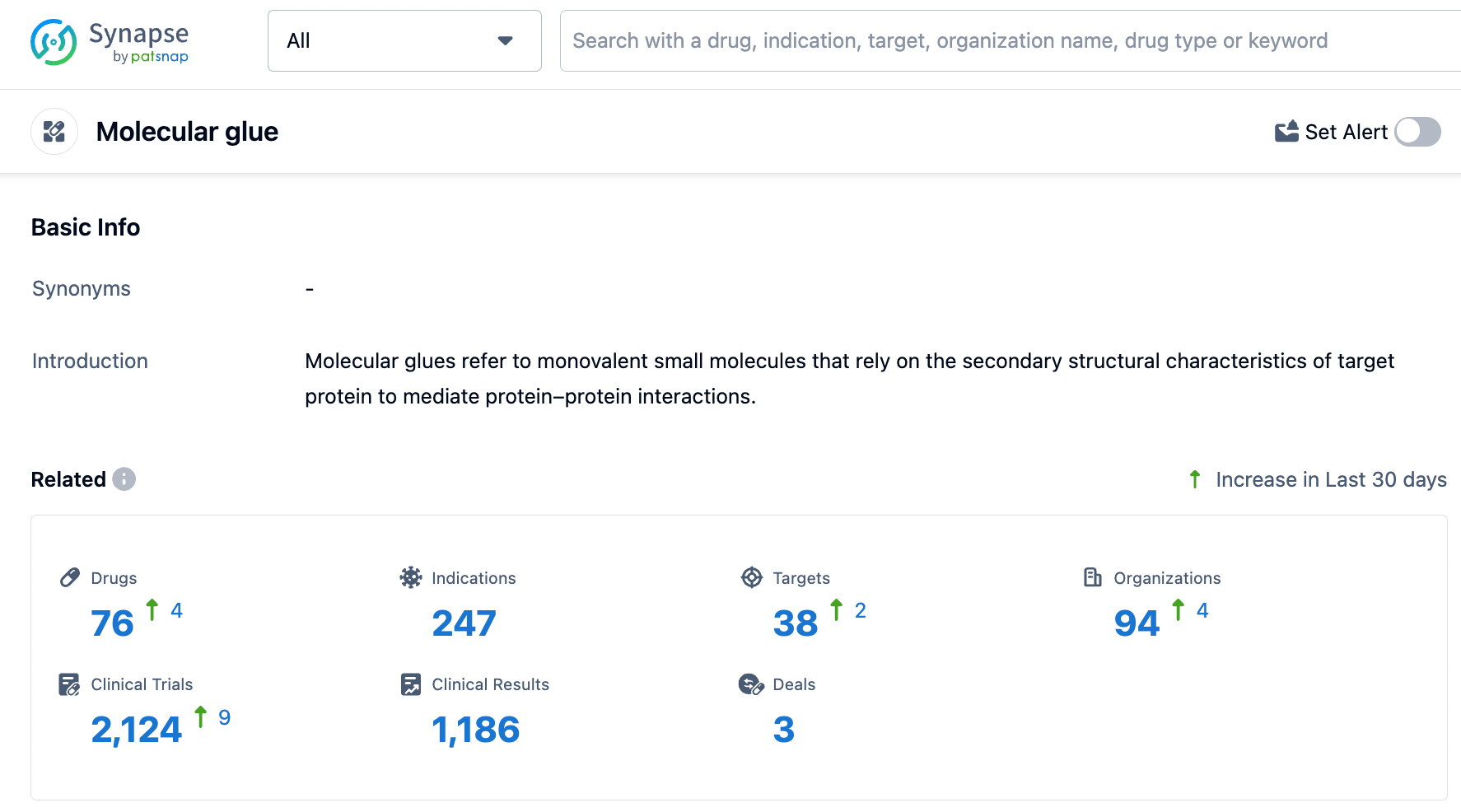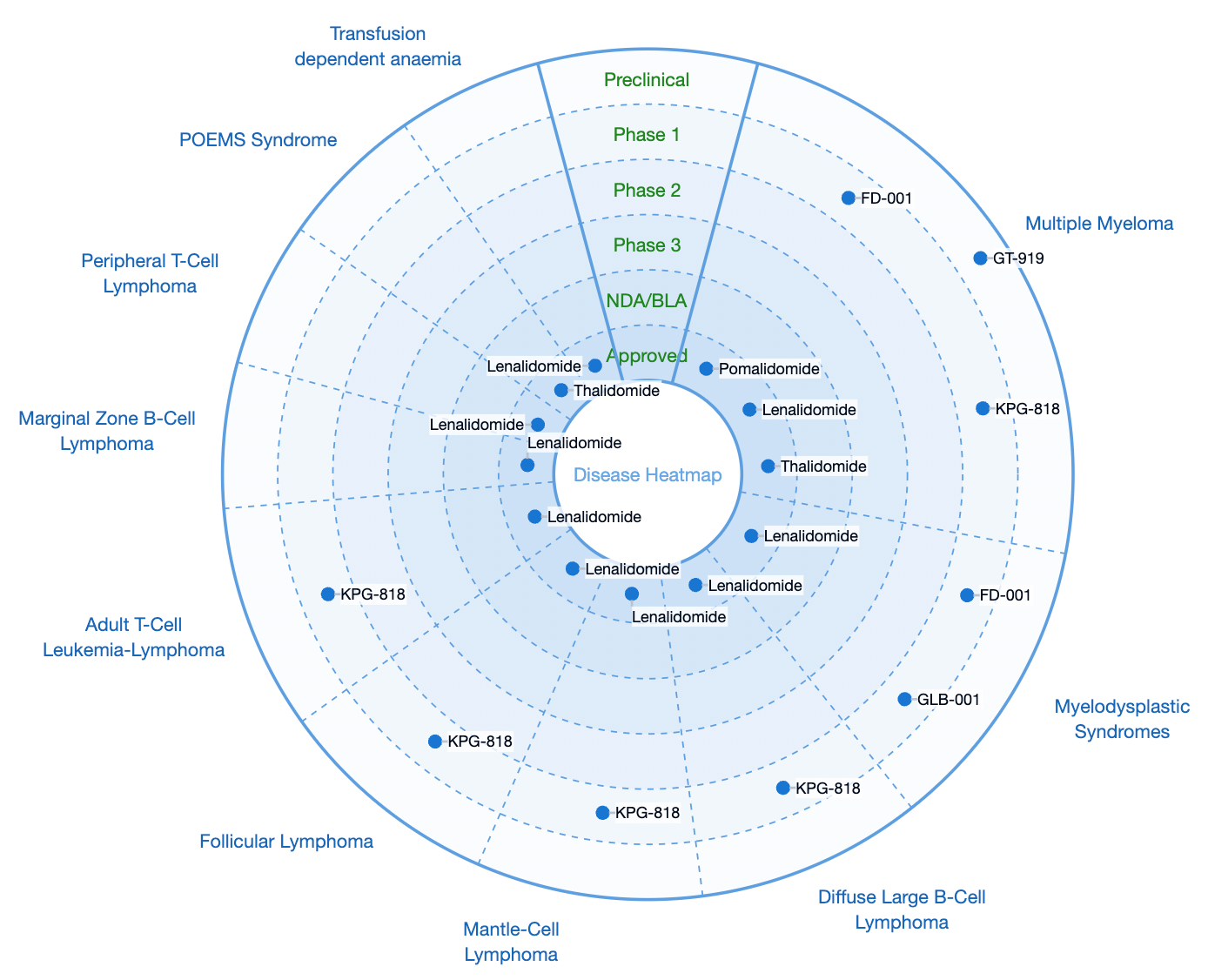Molecular Glue Decoded: The Next Big Trend in the Small Molecule Drug Arena
Molecular glues, since their initial discovery in the early 1990s, have gradually become a hot research area in the scientific community and pharmaceutical industry. They facilitate the binding of degrading enzymes to proteins that are typically difficult to target, by altering the shape of specific degradation enzymes, thus enabling targeted protein degradation. This characteristic is especially valuable in the fields of oncology and the treatment of rare diseases, as many disease-related proteins have not been effectively targeted by traditional small molecule drugs or antibody therapies to date.
Among them, the most popular molecular glue drugs on the market are immunomodulatory imide drugs (IMiDs), such as thalidomide and its safer analogs, particularly lenalidomide, with sales exceeding $6 billion in 2023.
Although these drugs are currently used for the treatment of certain types of blood cancers and some autoimmune diseases, their potential applications in other indications underscore the broad prospects of molecular glue technology in the medical field.
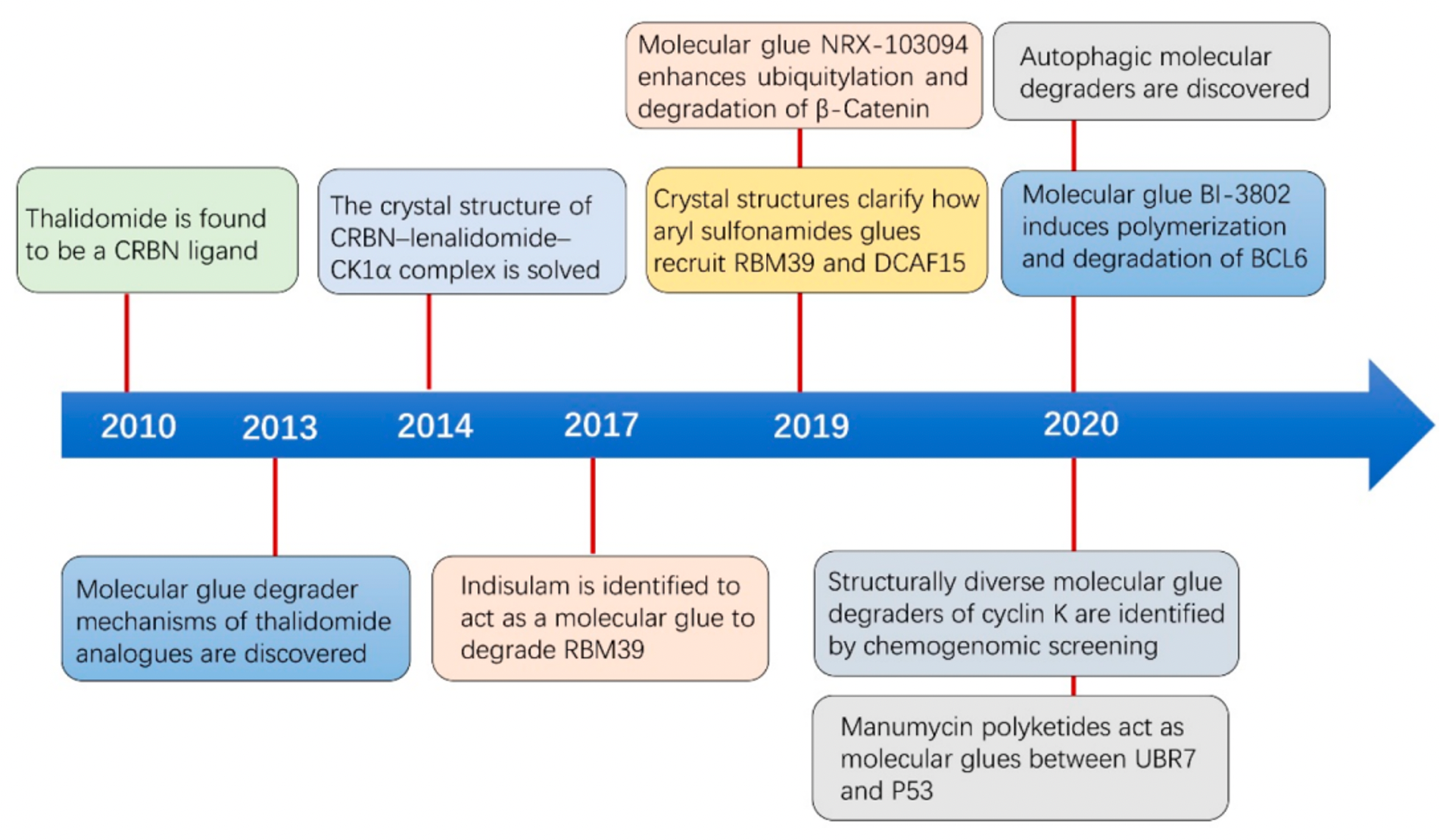
In recent years, significant progress has been made in the discovery and design of molecular glue degraders, and they are gradually becoming a promising therapeutic approach.
A search in the Synapse database using the keyword "Molecular glue" revealed that, as of April 10, 2024, there are a total of 76 drugs related to molecular glue that are either in development or on the market, involving 247 indications, 38 targets, and 2,124 clinical trials, of which 3 resulted in drug transactions.
The top ten indications for proteolysis targeting chimeras (PROTACs) are focused on oncological diseases and related areas. The newly approved drugs selinexor, pomalidomide, and lenalidomide are used for the treatment of multiple myeloma. Additionally, lenalidomide has another indication for the treatment of diffuse large B-cell lymphoma. The majority of other indications target hematological malignancies, and other types of cancer, with most of them being in the preclinical or Phase 1 clinical trial stages.
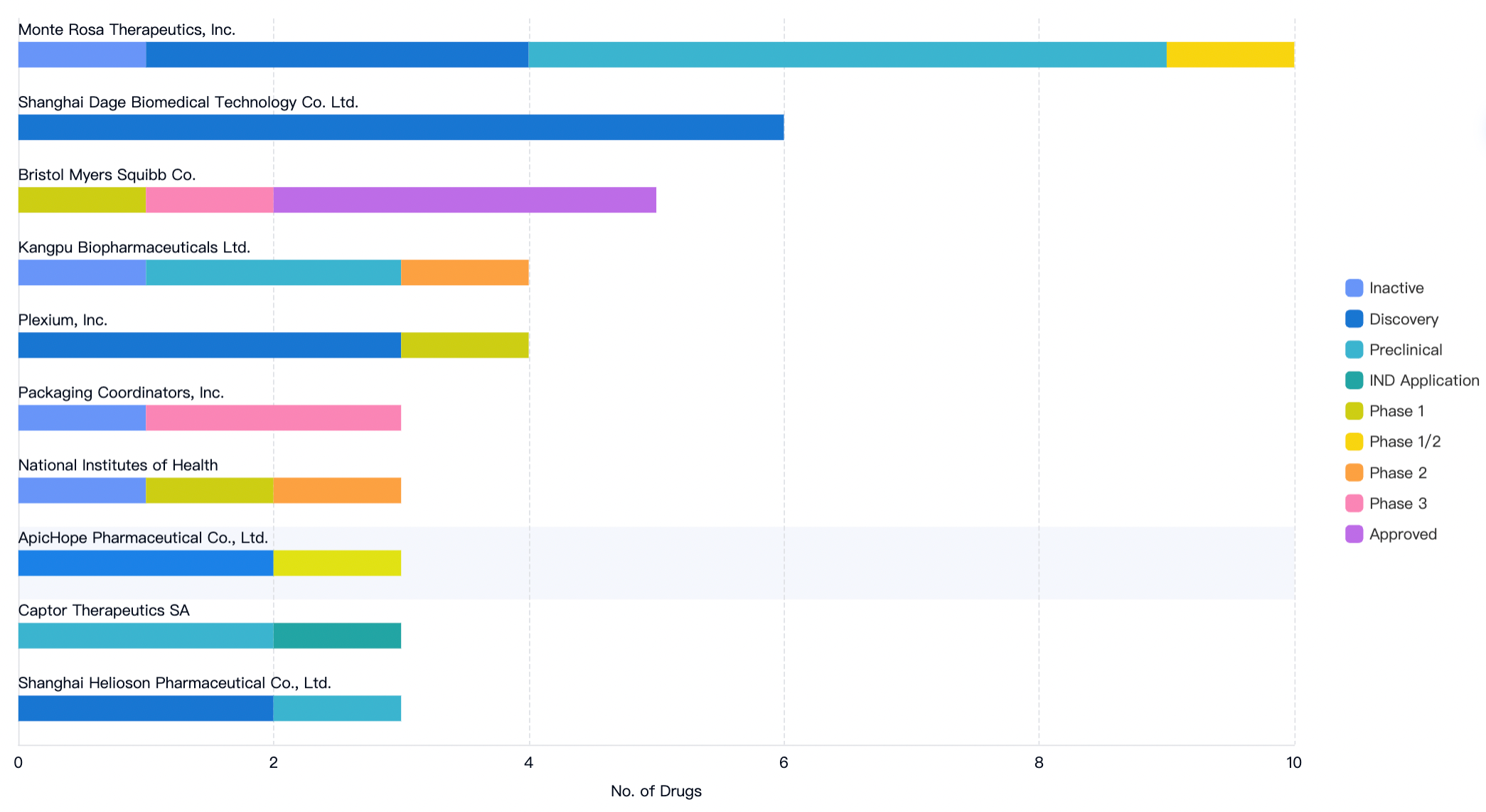
All molecular glue drugs approved for the market originate from Bristol Myers Squibb. The company is also developing a molecular glue named mezigdomide and has published clinical phase 1/2 trial data. These data demonstrate that mezigdomide, when used in combination with dexamethasone, exhibits a good therapeutic effect in patients with multiple myeloma (MM) who have undergone extensive prior treatment.
Increased investment by large pharmaceutical companies in molecular glue technology
As the potential of molecular glue technology becomes increasingly apparent, pharmaceutical companies are beginning to invest more heavily in this area. Novo Nordisk announced a collaboration with Neomorph, a biotech company based in San Diego, USA, to develop molecular glues for the treatment of rare diseases. The specifics of the payment have not been disclosed by the partners, but the total transaction could be worth up to $1.46 billion, plus tiered royalties.
In addition to Novo Nordisk, several other top pharmaceutical companies have made significant investments in the field of protein degradation, particularly in molecular glue technology. For example, Merck signed a collaboration and licensing agreement with C4 Therapeutics, valued at an estimated $2.5 billion, for the development of degrader-antibody conjugates (DACs), which are intended to selectively target and neutralize pathological proteins in cancer cells. Additionally, the collaboration between Seagen and Nurix Therapeutics, as well as the partnership between Sanofi and Kymera Therapeutics for the treatment of atopic dermatitis and hidradenitis suppurativa, reflect the growing interest and investment in this technology within the pharmaceutical industry.
Molecular Glue Mechanism of Action
Molecular glues are a class of small-molecule compounds that influence the interactions between proteins through a unique mechanism. The core function of these compounds is to facilitate binding between specific proteins, particularly those that do not readily interact under natural conditions, thereby triggering specific biological effects within cells.
In the strategy of targeted protein degradation (TPD), molecular glues play a crucial role. They have the ability to "glue" target proteins and E3 ubiquitin ligases, the latter of which are responsible for attaching ubiquitin tags to proteins in cells, signaling these proteins for degradation. This approach is particularly suited for so-called "undruggable" proteins, that is, proteins that are difficult to target with traditional small-molecule drugs and antibody therapies. Through this mechanism, molecular glue technology has opened up new therapeutic domains, especially in the study of oncology and rare diseases.
Application and Market Performance
1.Immunomodulatory imide drugs (IMiDs): The most popular molecular glue examples in the market
Immunomodulatory imide drugs (IMiDs) represent a major success of molecular glue technology in clinical applications. These drugs, including thalidomide, lenalidomide, and pomalidomide, exert their therapeutic effects by altering interactions between proteins.

They were initially developed to treat specific types of blood cancers, such as multiple myeloma, as well as some autoimmune diseases. IMiDs function by binding with the target protein CRBN (a critical component of the E3 ubiquitin ligase), changing its interaction with other proteins, and thereby inducing the degradation of disease-related proteins. Lenalidomide is the most prominent example among these drugs, with its sales exceeding $6 billion in 2023. This reflects the significant position of IMiDs in the treatment of blood cancers and the notable therapeutic benefits they provide.
Beyond blood cancers, IMiDs are also being investigated and used in the treatment of other autoimmune diseases, demonstrating the broad application potential of this class of drugs.
2.Sales Potential of Molecular Glues in Other Indications
Despite the significant accomplishments of IMiDs in the treatment of blood cancers and autoimmune diseases, the application and sales potential of molecular glue technology in other indications remain underexploited. Molecular glues have a unique advantage in developing new therapies due to their ability to target proteins that are challenging for traditional small molecules and antibodies to affect, particularly in disease areas where the response to existing treatments is poor. In the future, with further research and technological advancements, molecular glues have the potential to break through in a variety of indications, including but not limited to rare diseases, neurological disorders, and certain intractable conditions.
With the rise of personalized medicine and precision therapy, the flexibility and customizability of molecular glue technology make it a powerful tool for future drug development. By targeting unique disease biomarkers of specific patient groups, molecular glue holds the promise of developing more precise and effective treatment strategies, thereby creating significant economic value in markets that have not yet been fully exploited.
Investment and Market Dynamics
1.Bio-pharmaceutical company Salarius acquires molecular glue target SP-3164
On January 13, 2022, the biopharmaceutical company Salarius expanded its oncology pipeline through the strategic acquisition of the targeted protein degradation portfolio from DeuteRx, LLC. The acquisition included the molecular glue degrader target SP-3164 (formerly known as DRX-164), additional protein degradation projects, and related intellectual property rights. SP-3164 is expected to enter the clinical stage in 2023. DeuteRx received an upfront payment from Salarius that included $1.5 million in cash and 1 million shares of restricted stock. Depending on the success of SP-3164, DeuteRx is entitled to future milestone payments driven by clinical and regulatory events of up to $53 million, sales achievement milestones of up to $135 million, and escalating net sales royalties. Additionally, DeuteRx is eligible for up to $84 million in event-driven clinical, regulatory, and sales achievement milestone payments for future products, along with increasing net sales royalties.
2. Proxygen announces a collaboration and licensing agreement with MSD for the discovery and development of novel molecular glue degraders
On April 5, 2023, Proxygen, a leader in the discovery and development of molecular glue degraders, announced a multi-year research collaboration and licensing agreement with Merck & Co., Inc. (MSD) to identify and develop molecular glue degraders for multiple therapeutic targets. Under the agreement, Proxygen will receive an upfront payment from MSD and is eligible for future payments of up to $2.55 billion, as well as royalties on net sales from any such products.
3.Xencor, MorphoSys, and Incyte Announce Global Development Collaboration for Tafasitamab and Plamotamab
On November 11, 2020, Xencor, MorphoSys, and Incyte announced the initiation of a clinical collaboration to study the combined application of tafasitamab (Tafasitamab), plamotamab (Plamotamab), and lenalidomide in patients with relapsed or refractory diffuse large B-cell lymphoma, first-line DLBCL, and relapsed or refractory follicular lymphoma. The president of Xencor stated that plamotamab can redirect T cells to the tumor, and the collaboration aims to provide new insights for patients and accelerate the development timeline. The CEO of MorphoSys claimed that the combination of tafasitamab and lenalidomide is an important new treatment option, and it can add value to new combinations. Xencor's plamotamab is a tumor-targeting bispecific antibody, and MorphoSys's tafasitamab is a CD19-directed antibody that has been approved for use in combination with lenalidomide for specific patients. According to the agreement, the companies plan to initiate studies to evaluate the effect of this combined application in different patient populations, with MorphoSys and Incyte providing tafasitamab and Xencor sponsoring and funding the research, planned to be conducted across multiple regions.
4.Novo Nordisk Partners with Biotech Company Neomorph to Develop Molecular Glues
In February 2024, Novo Nordisk announced a collaboration and licensing agreement with the American biotechnology company Neomorph to jointly develop a range of molecular glue degraders for the treatment of cardiac metabolic diseases and rare disorders. Valued at approximately $1.46 billion, the deal covers multiple research targets. Under the agreement, Neomorph will be responsible for discovery and preclinical research stages, while Novo Nordisk will have exclusive rights to subsequent clinical development and commercialization. This marks a significant investment in the field of molecular glues, demonstrating the recognition and confidence of large pharmaceutical companies in the revolutionary potential of this emerging technology.
This collaboration exemplifies a broad trend in the pharmaceutical industry where more traditional pharma companies are increasingly turning their attention to innovative therapies, such as molecular glue technology, to address medical challenges that traditional treatment methods have struggled to overcome. By partnering with biotech innovators, large pharmaceutical companies can expedite the development and commercialization of these new technologies, while also providing biotech companies with the necessary resources and platform to translate their scientific achievements into market success.
5.Growth in Venture Capital Deal Value in the TPD Market and Its Impact
Between 2022 and 2023, the venture capital deal value in the Targeted Protein Degradation (TPD) market grew by 2000%, a significant increase that reflects investors' high interest in TPD technology and optimistic expectations, particularly in the research of molecular glues. Although this growth was not solely concentrated in the molecular glue sector, as an important component of the TPD field, molecular glues undeniably benefited considerably from this investment wave.
The growth of this investment trend is expected to have the following impacts on molecular glue research:
◆ Acceleration of R&D processes: With increased funding, related research and development efforts are accelerated, leading to more frequent new research findings and technological breakthroughs, contributing to the maturity and application of molecular glue technology.
◆ Expansion of application scope: The additional resources provided by increased investments enable researchers to explore the use of molecular glues across a broader range of disease treatments, thereby expanding their potential market and therapeutic scope.
◆ Promotion of cross-disciplinary collaboration: The substantial venture capital not only attracts the involvement of biotechnology companies but also encourages cooperation among scientists, research institutions, and enterprises from different backgrounds, strengthening interdisciplinary exchange and collaboration, and fostering the integration of innovative thinking.
◆ Higher industry attention: The notable investment growth has raised the pharmaceutical and biotechnology industry's awareness of molecular glue technology, attracting more research talent and companies to join the research and development in this field.
In summary, the investment growth in the TPD market not only reflects the market's recognition of the potential of molecular glue technology but also provides a strong impetus for research and application in this area, indicating that molecular glue technology will play an increasingly important role in future pharmaceutical research and treatment.
Molecular Glue Compared with Other TPD Technologies
1.Differences and Application Range of Molecular Glues and Proteolysis Targeting Chimeras (PROTACs)
Molecular glues and Proteolysis Targeting Chimeras (PROTACs) are currently two main types of targeted protein degradation (TPD) technologies. Although they share the same ultimate goal - to leverage the cell's natural degradation mechanisms to eliminate disease-related proteins, their mechanisms of action and application ranges fundamentally differ.
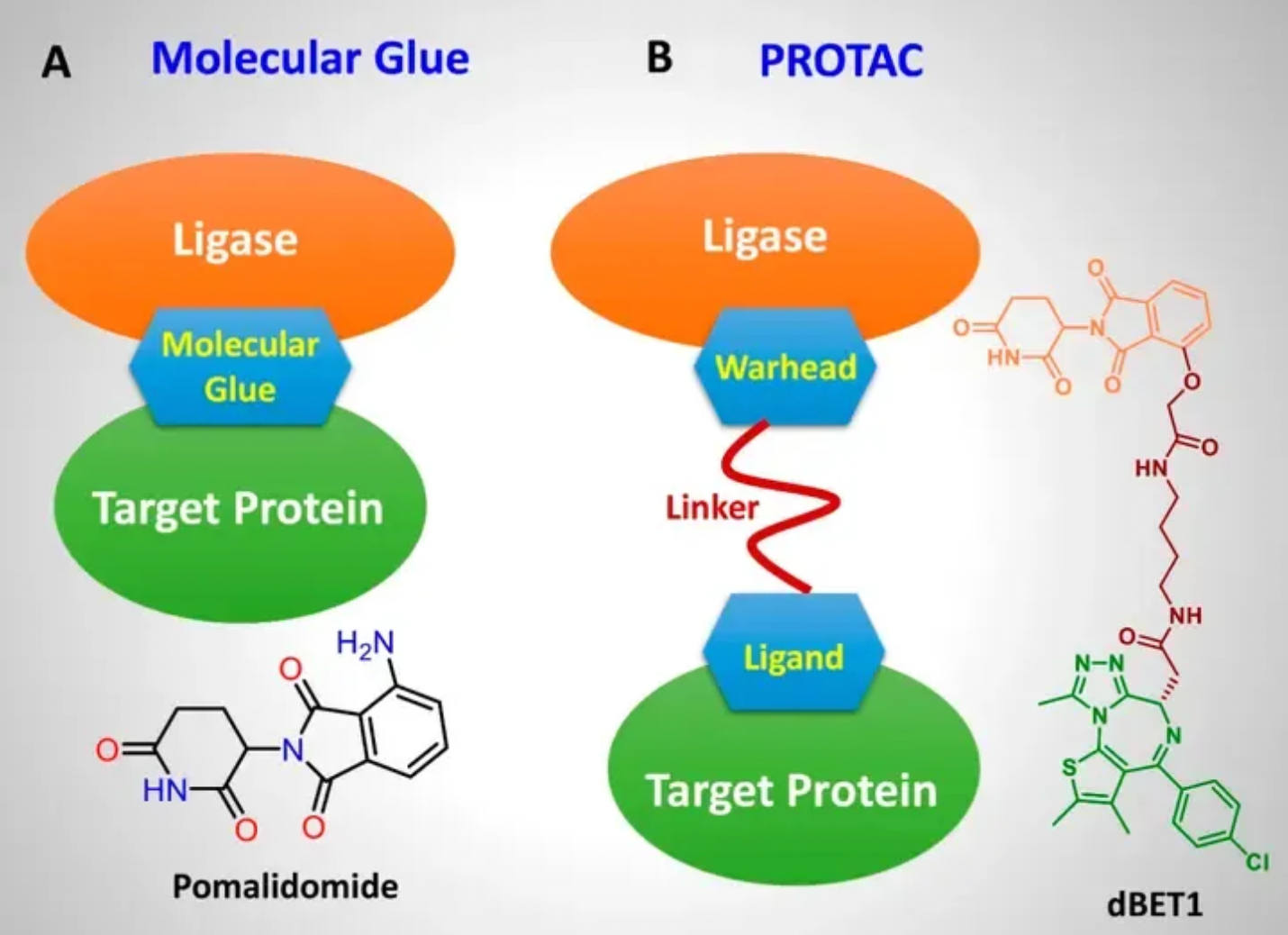
Molecular glues promote the interaction between degraders and target proteins, leading to the latter's degradation, by non-covalently altering the structure of the degraders. This approach does not require a direct linkage between the target protein and the E3 ubiquitin ligase but promotes their interaction indirectly by "gluing" around their environment. The advantage of this strategy is that it can apply to a broad range of protein targets, especially those traditionally considered "undruggable."
In contrast, PROTACs directly facilitate the proximity and interaction between these two proteins, triggering the degradation of the target protein through a bifunctional molecule whose ends bind to the target protein and E3 ubiquitin ligase, respectively. The design of PROTACs allows for more precise target selection and modulation, but this also demands an in-depth understanding of the binding sites on both the target protein and E3 ubiquitin ligase.
2.Design Limitations of PROTACs and Target Potential of Molecular Glues
Although PROTAC technology is distinctive for its precision and selectivity, its design and synthesis process is relatively complex, necessitating a comprehensive understanding of the interfaces between the target protein and the E3 ligase. Moreover, PROTAC molecules are often large, which may affect their intracellular permeability and stability. As a result, while PROTACs can theoretically be designed to target a wide range of proteins, in practice their applicability is limited by the available structural biology information and the challenges of synthetic chemistry.
Molecular glues offer a broader target potential in design and application. Since they do not rely on direct protein-protein interactions, molecular glues can target proteins that are traditionally difficult to modulate with small molecule drugs. This includes proteins that lack distinct active sites or whose active sites are challenging to block with small molecules. Additionally, the relatively small size of molecular glues means they generally have better cell permeability and bioavailability.
In summary, molecular glues and PROTACs each have their advantages and limitations. The choice of which technology to use depends on the specific application goals and the characteristics of the protein in question. Molecular glues, with their wide applicability and relatively simple design, show greater potential in certain areas, while PROTACs exhibit their strengths in applications requiring high selectivity and precision. As research continues and technologies advance, both strategies are expected to play significant roles in the future of drug development.
Prospect
1.Potential Applications of Molecular Glue Technology and the Role of Artificial Intelligence
The potential applications of molecular glue technology in future therapeutic schemes are immense, particularly in targeting diseases that are difficult for traditional drugs to address. With a deeper understanding of disease mechanisms, especially in fields such as oncology, rare diseases, and neurodegenerative disorders, molecular glue technology offers a novel means of intervention. It provides precise regulation of the activity or stability of disease-related proteins, thus delivering therapeutic effects.
Artificial Intelligence (AI) is playing an increasingly significant role in accelerating the drug discovery and development process. For molecular glue technology, AI can assist scientists in rapidly screening and optimizing potential molecular glue candidates, predicting their interactions with target proteins as well as degrading enzymes.
Furthermore, AI technologies can also predict the pharmacokinetics and toxicity profiles of drugs at early stages of development, thereby reducing the likelihood of failure and speeding up the transition of drugs from the laboratory to clinical trials. An example of this is the collaboration between Bristol Myers Squibb and the tech startup VantAI in designing and developing molecular glues, illustrating that the application of AI is becoming an important trend in the field of drug research and development.
2.Multipurpose Drug Development Strategies and the Adaptation of Molecular Glues in Large Pharmaceutical Companies
There are many examples of growth achieved by large pharmaceutical companies through multipurpose drug development strategies, with Novo Nordisk's GLP-1RA drugs being a notable case. This strategy not only increases the market potential of the product but also improves the efficiency of research and development investments, as the same drug can be developed and approved for multiple diseases or conditions.
Molecular glue technology is very well suited to this strategy because a single molecular glue can influence the stability or activity of multiple proteins, and thus may be applicable for the treatment of a variety of diseases. For instance, a particular molecular glue might initially be developed to treat a certain type of cancer but could later be found effective for treating certain autoimmune diseases or neurodegenerative disorders. This cross-disease domain potential makes molecular glues a powerful tool in the multipurpose drug development strategies of large pharmaceutical companies.
In conclusion, molecular glue technology has a broad application prospect in future medical treatment plans, and the support of artificial intelligence will further accelerate the development of this field. Meanwhile, the multifunctionality of molecular glue technology makes it an ideal choice for adapting to the multipurpose drug development strategies of large pharmaceutical companies, indicating its important position in the future pharmaceutical market.
Conclusion
1.The Significance of Molecular Glue Technology and its Revolutionary Potential
Molecular glue technology has become a significant branch in the field of pharmaceutical research and therapeutic development, offering a novel intervention for proteins that are difficult to target with traditional methods. Through its unique mechanism, molecular glue can interfere with protein-protein interactions, facilitating the degradation of disease-related proteins, thereby paving new paths for treating various diseases, especially in the fields of oncology, rare diseases, and neurological disorders. This technology not only demonstrates the necessity of a deep understanding of disease mechanisms but also reflects the trend towards more precise and personalized treatment developments in modern medical research.
The revolutionary potential of molecular glue technology lies in its ability to target "undruggable" proteins, overcoming a major challenge in traditional drug development. The prospective applications of this technology are vast, not limited to known disease targets but also encompassing newly discovered or formerly considered difficult-to-target new targets. Moreover, with the application of advanced technologies such as artificial intelligence in drug discovery and development, the process of identifying and optimizing molecular glues will become more efficient, further accelerating the revolution in this domain.
2.The Importance of Continuous Research and Investment
To fully unlock the potential of molecular glue technology, ongoing research and investment are crucial. In recent years, the biopharmaceutical industry has demonstrated great interest and anticipation for this emerging technology, as evidenced by partnerships such as Novo Nordisk's collaboration with Neomorph, and investment trends in the protein degradation domain by companies like Merck, Seagen, and Sanofi. These partnerships and investments have not only accelerated the research and development process of molecular glue technologies but have also laid the foundation for their commercial application.
In the future, as further understanding of disease mechanisms evolves and new technologies emerge, research into molecular glue technology will face new challenges and opportunities. Sustained scientific exploration, interdisciplinary collaborations, and ample funding support will be key factors in driving the development of this field. Through these efforts, molecular glue technology is expected to provide more effective and safer solutions for the treatment of a variety of diseases, ultimately benefiting all of humanity.
In summary, molecular glue technology represents a significant revolution in pharmaceutical research and therapeutic development. It challenges the traditional drug discovery paradigms and opens up new possibilities for the treatment of diseases in the future. Therefore, continuing to invest in research in this field and promoting collaborations between scientists and enterprises globally will be vital to ensuring that this revolutionary potential is realized.
Reference
- 1.Bartlett, J. Blake, Keith Dredge, and Angus G. Dalgleish. The evolution of thalidomide and its IMiD derivatives as anticancer agents[J].Nature Reviews Cancer4, no. 4 (2004): 314-322.
- 2.Guoqiang Dong, Yu Ding, Shipeng He, and Chunquan Sheng. Molecular Glues for Targeted Protein Degradation: From Serendipity to Rational Discovery[J].J. Med. Chem. 2021, 64, 15, 10606–10620.
- 3.Manalac,T.Novo Inks Potential$1.46B Deal to Tap Neomorph’s Molecular Glue Platform.BioSpace.27.02.2024.
- 4.Using"Molecular Glues"to Hijack the Body’s Garbage Disposal System.Pfizer.Retrieved on 27.02.2024.
- 5.Goodwin,K.Genentech Doubles Down with Orionis Deal Worth up to$2B for Glue Degraders.BioSpace.21.09.2023.
- 6.Goodwin,K.Proxygen Snags Third Big Pharma Partner in Deal Valued at$2.55B.BioSpace.05.04.2023.
- 7.Bouvier,C.et al.Breaking Bad Proteins–Discovery Approaches and the Road to Clinic for Degraders. doi:10.20944/preprints202402.0637.v1.12.02.2024.
- 8.Shah-Neville,W.Seven molecular glue startups looking to stick around in the biotech industry.Labiotech.24.10.2023.
